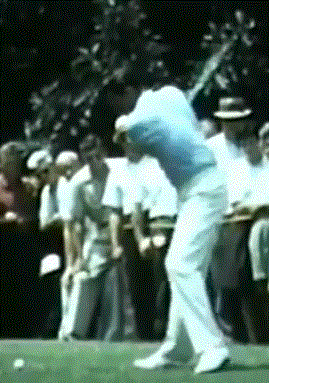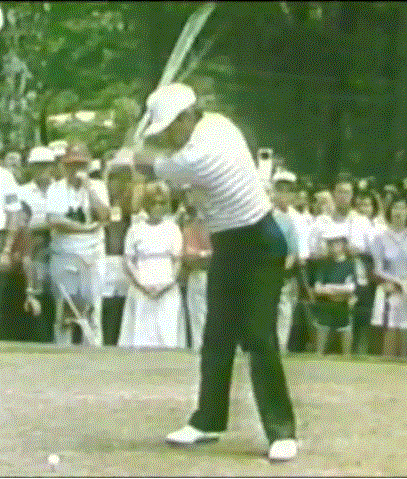Seeing I just interviewed Doug Sanders for our site I thought it would be good to extract a few nuggets from his 1964 book about the swing- Compact Golf
As he mentioned in the interview there is a lot of merit to having a shorter hand swing going back and a wide stance. Here are some great thoughts from his book.
CHAPTER 1
“Anyone that wants to play golf for very long and improve and enjoy it, has to build a game that will be dependable under many conditions and on many different types of golf courses”
“Hitting a golf ball is a physical act.If you know something about your swing, can control it and feel what it’s doing, then you stand to improve your score and start winning more often”
“Because my stance is quite wide and use not a lot of body turn, the action looks awkward and unnatural. The fact is that it feels natural to me. Sam Snead’s flowing move has been used as the ideal model for twenty five years. Yet no-one else can swing like Sam, so in one sense every golfer has an unnatural swing”
“One thing which my swing type can do easily, that the longer sweeping swing has trouble doing, is hitting control shots. With a short swing and little body turn I can hit shots down very low or up very high, or hook or fade as much as I want. Long swingers have to rely on their big body turn to get back into position. Mine is in my hands. I have the feel there and do the work there.”
My thoughts: You need to know YOUR swing and be able to FEEL your swing. It is no good trying to swing like Tiger Woods or Jack Nicklaus if you don’t understand the motion and feel the motion you are trying to create… Doug talks a lot here about being able to FEEL the swing…FEEL the hands…this is one reason I really love the module work because it isn’t a guess or an attempt at a swing. It is diligent work based on allowing you to FEEL the motion and make it your natural motion, He also talks about conditions and different courses. Golf is not played from a flat driving range so you need to work on all different types of grass and ground conditions and uphill,downhill, sidehill…remember on the course you don’t get to drag another ball over for a re-do like you can on the range…get some course time in to improve and not just be a ball beater
CHAPTER 2
“My swing is really not too much different from that of anyone else in my league. The most noticeable differences are the wider stance and the shorter or more restricted backswing. But if you were to match photos of my swing with someone else’s- put my feet 8-12 inches closer together and extend my hands another 8-12 inches higher- my swing would be just about the same. So the fact is that my swing is not unorthodox at all. It’s just that I don’t continue the arc back quite as far. I feel that this shorter swing demands a wider stance, this gives the leverage for maximum distance and power”
“Building a perfect championship swing takes years of constant practice. This is impossible for a person who’s playing only on Saturdays or men’s days on Thursday’s or even both. Their muscles simply aren’t toned to be whipping a club around the way Jimmy Demaret has been doing for forty years.”
“The principle behind using a shorter swing is this simple: any time you shorten any kind of precision movement, you have less margin for error. It’s just like throwing darts at a target board. The closer you move in, the better chance you have to throw a bulls eye. The farther back you move, the longer and harder the throw you must make. You make fewer bulls eyes. The point being is that the short swing is much more likely to get the shot started in the right direction and to put it in better shape down the fairway”
“If a person would cut down their swing and use more force right at impact, they would get a lot more distance. A long loose swing doesn’t necessarily generate clubhead speed; it just looks pretty. The simple fact is thata golfer who cannot keep the ball in the fairway a high percentage of the time will never score consistently well”
My thoughts:This is very much in tune with a shorter hand swing…as per Sam Snead diagram in his book and even though Hogan had a long clubhead swing he actually had a reasonably short hand swing going back. The ‘more force at impact’ logic is right on the money… the later you can speed up the more angles created to deliver to the ball…and the more mass can be delivered to the ball. Once you speed up too soon…the party is over, all bets are off and you will have a tough time…He talks about toning the muscles …this is the impact bag we use here to aid the students and tone their correct golfing muscles…again all his thoughts here are very much in tune with the ABS module work
CHAPTER 3:
“The rules of golf don’t say anything about how a player has to swing at the ball, just what type of club he has to use. A person’s size, shape, temperament, age, co-ordination, strength and other factors will decide what his swing looks like and how it performs. Unless the person is more vain than he is anxious to play the game well, he shouldn’t give a hang what his swing looks like. It’s the results that count”
"Some of the prettiest swings in the world are wasted on clipping dandelions before the average golfer ever hits a ball. It’s surprising how many golfers have an uncomfortable passion to hit a longer ball than they can usually control"
"Golfers who try to imitate their heroes and swing trying to look pretty and yet looking terrible by swinging from their heels for distance have trouble putting any type of round together. They need to forget about how they look and how far they can hit the ball and think instead about where the next shot should land and how they are going to get the ball from here to there"
“The ONLY important part of a golf swing is getting the club in position two feet before it reaches the ball on the downswing and two feet after it passes through the ball. So in retrospect it is much easier to maintain the same pattern every time with a short swing than one that comes from up behind the head”
My thoughts: Dynamics of the swing are far more important than the so called 'pretty ’ swing. Work on your dynamics and the ball will take the correct route. Doug clearly states the P3 to P4 position and as Lag calls it - the hitting arena- is the most important part of the swing. The ABS students know this is the crux of the module work and why we talk so much about keeping the club and shaft on it’s true plane from hip high down to hip high through. Control of the ball should be the goal…Also plan ahead. Get the ball in position to make your next shot easier. Very basic simple logic that has become forgotten in much of today’s golfing circles

